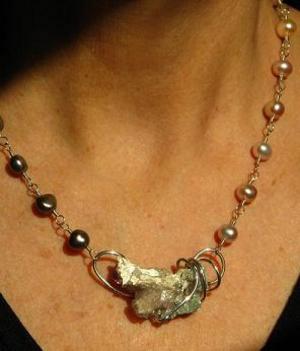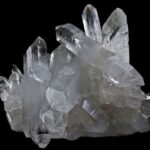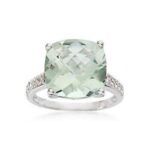Amethyst is yet another silicate gemstone. Simply silicon dioxide, SiO2, amethyst is the violet variety of quartz, which is white. So what causes the purple color?
The subject of much debate, amethyst’s purple color was believed to be from manganese. Also from sulfur. Perhaps also from ferric thiocyanate. The purple color had many postulated origins. Recent work in color investigation is settling on impurities that contain iron as the color-causing element, especially when atoms of aluminum are present as well.
What’s more interesting is that the purple color can change on exposure to heat and light. A tip for the gals: remove your amethyst jewelry before sunbathing. I’ve seen some amethyst stones pale to yellow and near white in daylight. Also, dancing under “black light” in dance clubs might change the color of your amethyst as well. Restoring the color is technically possible by irradiating with radium. But I’m not aware of any jewelry store that offers that radioactive service.
The largest sources of amethyst are Brazil, Uruguay, Zambia, and Madagascar. Amethyst is found also all over the world, including Germany, Russia, Sri Lanka, South Korea, Austria, Mexico, Ontario, Canada, and in the United States primarily in Arizona.
If you were born in February, amethyst is your birthstone. If purple is your favorite color, you’re wishing you were born in February. Amethyst joins charoite as the other purple gemstone, but their purples are very different. The purple color of amethyst ranges from light, nearly white pale pink to a deep violet hue. No two pieces of amethyst seem to be exactly the same shade of purple. Variations range from red to blue.
Among the many myths about the name “amethyst,” the most enduring story is one that explains how amethyst got its purple color. It involves wine, clear quartz and, of course, a couple of Greek gods. Dionysus, the Greek god of intoxication, pursues Amethystos, a beautiful, young, godly Greek maiden. Amethystos, unfortunately, does not wish to return old Dion’s affections, even prays to the Greek goddess, Artemis, for aid in maintaining her chastity. As the story goes, Artemis went beyond aid and changed Amethystos into white stone (a really radical way to preserve chastity, if you ask me!). This conversion so humbled Dionysus that he made an offering of wine, pouring it over the white stone figure of Amethystos, thereby turning the white stone purply red. Wah laa, amethyst!
What I get from this story, mythology or not, is that paled out amethyst might be restored with color by a dip in a glass of merlot. I’m curious myself, and I’m going to give it a try. (And, starting now, I’ll think twice about what I wish for.) Check back with me soon for the results of the wine experiment.
In the meantime, enjoy your amethyst, however it got to be the color purple.
Sources: personal experience;
www.gemstone.org/gem-by-gem/english/amethyst.html;
http://en.wikipedia.org/wiki/Amethyst





